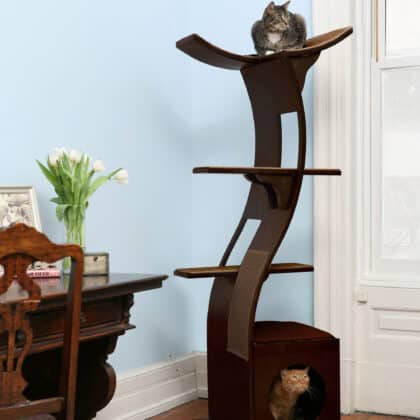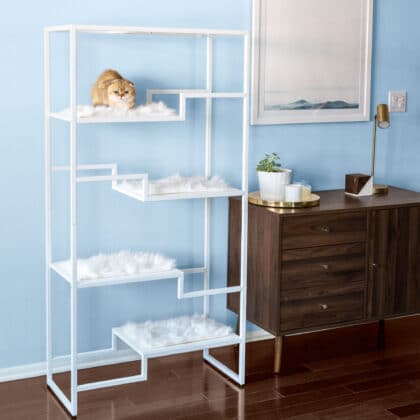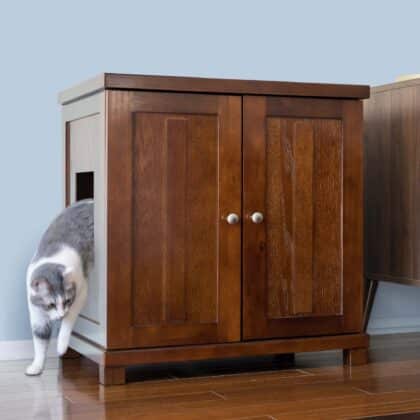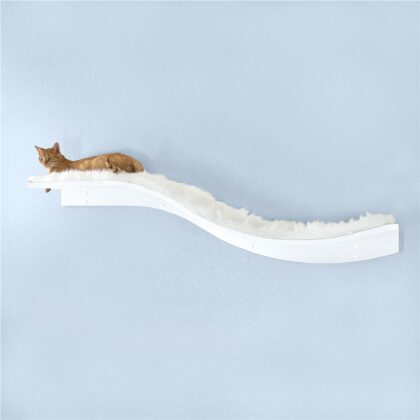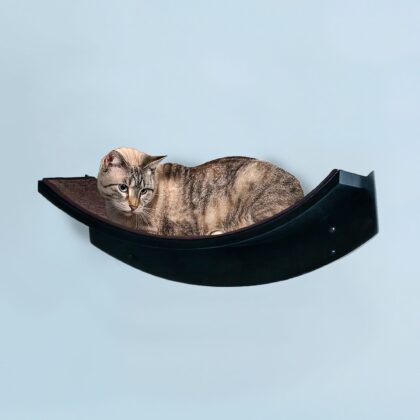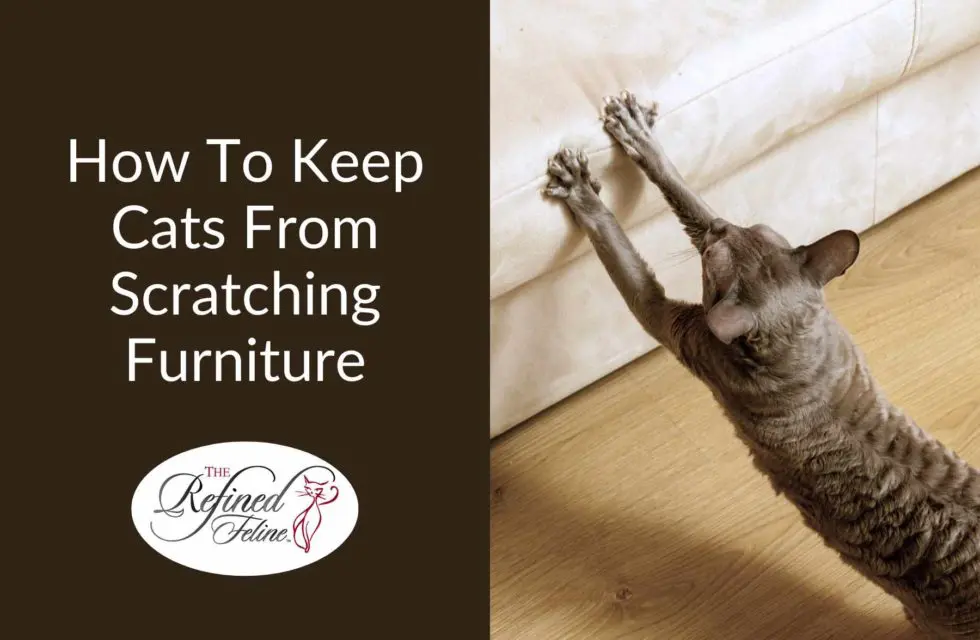
How To Keep Cats From Scratching Furniture
Cats are lovable creatures, but their natural instinct to scratch can wreak havoc on your furniture. However, there are several useful methods that can help redirect their scratching behavior and save your beloved couches and chairs from ultimate destruction. In this blog post, The Refined Feline will explore a variety of ways to deter cats from scratching your furniture. They range from providing suitable alternatives to employing behavioral modifications. By understanding why cats resort to scratching behaviors and implementing these practical solutions, you can create a harmonious environment where both you and your feline companion can coexist peacefully!
Keep Cats From Scratching Furniture With These Tips
- Understand the Reasons Why Cats Scratch
- Provide Suitable Alternatives
- Protect Your Furniture & Provide Deterrants
- Behavioral Modification and Training
- Environmental Enrichment
Understand the Reasons Why Cats Scratch
Before delving into the strategies, it is important to understand why cats scratch in the first place. Scratching is essential to a cat’s well-being and serves several purposes. Scratching behavior can be managed with these strategies and it is not recommended to declaw a cat.
Cats Scratch to Mark Their Territory
If you’re a fellow cat parent, then you have experienced how territorial these adorable felines can be. Cats have scent glands in their paws that leave behind a scent mark, asserting ownership of an area. By scratching furniture, they are releasing their scent to make it known what is theirs!
Cats Scratch To Maintain Their Nails
You may be no stranger to finding old layers or pieces of cat claws scattered around your house floor. That’s because scratching helps cats shed old layers of their claws, keeping them sharp and healthy. A helpful tip is to try providing a designated cat scratcher that your cats can use instead of your precious furniture.
Scratching Helps Cats Stretch
It’s important to keep your cats active and healthy! Scratching is an excellent way for cats to stretch their bodies and exercise their muscles. Several scratching posts with toys attached would make the perfect distraction from your furniture. By acknowledging these underlying reasons for scratching behaviors, we can develop and use effective techniques to redirect their scratching behavior toward more appropriate alternatives.
Provide Alternatives To Keep Cats From Scratching Furniture
To protect your furniture and create a harmonious home for you and your cat, it is important to offer cats appealing and suitable alternatives to scratch. There are many different types of alternatives that you can offer your cats.
Tall Scratching Posts
Tall vertical scratching posts are great for distracting cats from the furniture. Make sure to invest in tall durable scratching posts made of sisal rope or heavy cardboard that can withstand clawing. You will want to place them strategically near the furniture they tend to target to encourage scratching these items instead. When choosing a vertical scratching post, you want to ensure that it is tall enough that your cat can fully extend their body while scratching.
Horizontal Scratching Pads
In addition to vertical scratching posts, there are also horizontal scratching pads available. Some cats like to scratch both vertically and horizontally and some cats prefer to just scratch horizontally! By providing flat scratching pads as well as horizontal ones, you can figure out your cat’s preferences. Make sure to place these pads in areas where your cat spends a lot of time, such as near their favorite napping spot.
Cat Trees And Condos
Investing in tall cat trees and multi-level cat condos for your furry felines is beneficial for many reasons! These multi-tiered pieces of cat furniture provide a combination of scratching surfaces, climbing opportunities, and resting spots for cats. You will want to choose a large cat tree or condo with built-in scratching posts to incorporate into your cat’s play area.
If you need help encouraging your cat to use these alternatives, try to sprinkle catnip on the surfaces or use interactive toys to attract their attention. You want to reinforce positive behavior by praising and rewarding your cat when they choose to scratch their designated areas. This positive reinforcement will encourage them to use their scratching pieces more frequently and they will soon forget about your home furniture!
Protect Your Furniture & Provide Deterrants
While providing suitable alternatives is important, it is also a good measure to protect your furniture from your cat’s natural scratching behaviors. This is most important when the cat is young or when you bring a new cat into the home.
Double-Sided Tape
Try applying double-sided tape or sticky tape to the targeted areas of your furniture. This can deter cats due to the unpleasant texture of the double-sided tape. Cats are not fond of the sticky sensation on their paws and will be less inclined to scratch those surfaces.
Furniture Covers And Throws
Another effective form of protection is furniture covers and throws. You can use washable covers or throws to protect furniture temporarily. Cats may find the texture unappealing or inconvenient to scratch. Make sure that the covers are securely placed and provide alternative scratching surfaces nearby for best results.
Plastic Or Aluminum Foil
This one may sound off, but using plastic wrap or aluminum foil can deter your cats from scratching furniture. By covering furniture with plastic or aluminum foil, you can discourage scratching as cats dislike the sensation under their paws. The crinkling sound produced by foil can further deter them as the sound is displeasing to them. However, be aware that some cats may be undeterred by this method. If that is the case, there are many other solutions available.
Scent Deterrants
Cats are very sensitive to certain smells. Try to utilize citrus-scented sprays, eucalyptus oil, or other cat-safe repellents on furniture surfaces to discourage scratching. You always want to test the repellents on a small, inconspicuous area first to ensure they don’t damage the furniture.
Behavioral Modification and Training
In addition to providing alternatives and deterrents, behavioral modifications and training strategies can help redirect your cat’s scratching behavior.
Regular Nail Trimming
Nail maintenance and trimming are important for overall cat health and discourage furniture scratching tendencies. Keeping your cat’s nails trimmed reduces the potential damage caused by scratching. Cats with shorter nails are less likely to cause significant harm to furniture. Make sure to consult a veterinarian or a professional groomer for guidance on proper nail-trimming techniques.
Soft Paws Or Nail Caps
Try applying soft paws or nail caps to your cat’s claws to help minimize the impact of scratching on furniture. These caps are safe and painless and can be easily applied at home. Make sure to seek assistance from a veterinarian or follow the manufacturer’s instructions when using these options.
Positive Reinforcement & Training
It is important to use positive reinforcement techniques such as treats, praise, and affection to encourage your cat to use appropriate scratching surfaces. Whenever you notice your cat scratching their designated areas, provide verbal praise or a small treat to reinforce the behavior. You want to avoid punishment or yelling, as it can lead to anxiety and negative associations.
Redirecting And Distracting
When you catch your cat scratching furniture, gently redirect their attention to a suitable alternative like a scratching post or pad. Try to use a toy or interactive game to engage them and encourage them to scratch the designated surface. With time, they will learn that the appropriate scratching areas are more rewarding.
Consistency And Patience
Remember, changing your cat’s scratching behavior takes time and patience. Make sure to be consistent with providing alternatives, using deterrents, and implementing behavioral modifications. You want to redirect your cat to the appropriate scratching areas when caught in the act, gently guiding them toward the designated surfaces. With persistence and positive reinforcement, your cat will gradually develop the habit of using the alternatives provided.
Environmental Enrichment
Creating an enriched environment for your cat can also help alleviate their need to scratch furniture. The following strategies will help modify their behavior so that you and your cat are both happy,
Vertical Space
Cats love to climb to be at a higher point of view! Try installing cat wall shelves, cat trees, or window perches to provide them with elevated spaces to explore and observe their surroundings. This will provide them with alternative surfaces for scratching and playing.
Interactive Cat Toys
You want to engage your cat in playtime using interactive toys that simulate hunting behaviors. This helps release their pent-up energy and redirects their instincts from scratching furniture. Make sure to rotate and introduce new toys periodically to keep their interest high.
Scratching Surfaces In Multiple Rooms
To protect the furniture around all parts of your home, you can place scratching posts or pads in various locations throughout your home to ensure your cat has accessible alternatives wherever they are. This allows them to scratch when the need arises, even if they are in a different room. If you don’t want carpeted cat furniture to ruin the aesthetic of your home, many types of modern cat furniture now exist.
Related: How to Introduce Your Cat to New Cat Furniture
Regular Cleaning And Maintenance
It is important to maintain cleanliness in your cat’s environment. Make sure to regularly clean and vacuum furniture to remove any lingering scents that might attract your cat to scratch. Additionally, keep the scratching surfaces clean and free from debris to make them more appealing to your cats. Cats are more likely to use clean and well-maintained scratching posts and pads, so remember to clean!
Seek Professional Help If Needed
If these strategies do not help to modify your cat’s behavior you may want to consider consulting a veterinarian or a professional animal behaviorist. They can provide personalized advice based on your cat’s specific needs and look for any underlying issues that may be contributing to this behavior. They may recommend additional techniques or behavioral therapies to address the issue effectively and safely.
Keep Your Cats From Scratching Furniture With These Tips
Preventing cats from scratching furniture requires a combination of understanding their instincts, providing suitable alternatives, using deterrents, implementing behavioral modifications, and creating an enriched environment. With consistency, patience, and a variety of strategies, you can successfully redirect your cat’s scratching behavior and protect your furniture. Declawing a cat should never be considered as it involves the amputation of the last bone of each toe in a cat’s paw. This is equivalent to cutting off a human’s fingers at the last knuckle. It causes significant pain and can lead to long-term discomfort and behavioral issues. Building a strong bond with your feline friend through positive reinforcement and understanding their needs is key to maintaining a harmonious and scratch-free home.



